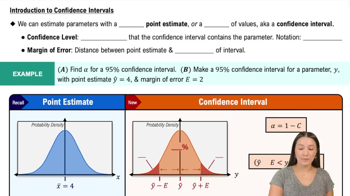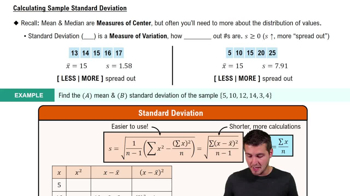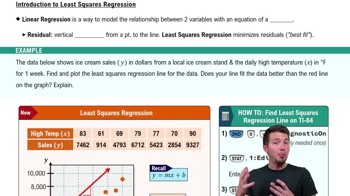Bachelor’s Degree The president of Brown University wants to estimate the mean time (years) it takes students to earn a bachelor’s degree. How many students must be surveyed in order to be 95% confident that the estimate is within 0.2 year of the true population mean? Assume that the population standard deviation is sigma=1.3 years
Table of contents
- 1. Intro to Stats and Collecting Data1h 14m
- 2. Describing Data with Tables and Graphs1h 55m
- 3. Describing Data Numerically2h 5m
- 4. Probability2h 16m
- 5. Binomial Distribution & Discrete Random Variables3h 6m
- 6. Normal Distribution and Continuous Random Variables2h 11m
- 7. Sampling Distributions & Confidence Intervals: Mean3h 23m
- Sampling Distribution of the Sample Mean and Central Limit Theorem19m
- Distribution of Sample Mean - Excel23m
- Introduction to Confidence Intervals15m
- Confidence Intervals for Population Mean1h 18m
- Determining the Minimum Sample Size Required12m
- Finding Probabilities and T Critical Values - Excel28m
- Confidence Intervals for Population Means - Excel25m
- 8. Sampling Distributions & Confidence Intervals: Proportion1h 12m
- 9. Hypothesis Testing for One Sample3h 29m
- 10. Hypothesis Testing for Two Samples4h 50m
- Two Proportions1h 13m
- Two Proportions Hypothesis Test - Excel28m
- Two Means - Unknown, Unequal Variance1h 3m
- Two Means - Unknown Variances Hypothesis Test - Excel12m
- Two Means - Unknown, Equal Variance15m
- Two Means - Unknown, Equal Variances Hypothesis Test - Excel9m
- Two Means - Known Variance12m
- Two Means - Sigma Known Hypothesis Test - Excel21m
- Two Means - Matched Pairs (Dependent Samples)42m
- Matched Pairs Hypothesis Test - Excel12m
- 11. Correlation1h 6m
- 12. Regression1h 50m
- 13. Chi-Square Tests & Goodness of Fit1h 57m
- 14. ANOVA1h 57m
7. Sampling Distributions & Confidence Intervals: Mean
Introduction to Confidence Intervals
Problem 7.3.16b
Textbook Question
Comparing Waiting Lines
The values listed below are waiting times (in minutes) of customers at the Bank of Providence, where customers may enter any one of three different lines that have formed at three teller windows. Construct a 95% confidence interval for the population standard deviation sigma.

 Verified step by step guidance
Verified step by step guidance1
Step 1: Identify the sample data provided. The waiting times are: 4.2, 5.4, 5.8, 6.2, 6.7, 7.7, 7.7, 8.5, 9.3, and 10.0 minutes. Note that the sample size (n) is 10.
Step 2: Calculate the sample variance (s²). First, compute the sample mean (x̄) using the formula: . Then, use the formula for variance: .
Step 3: Use the Chi-Square distribution to construct the confidence interval for the population standard deviation (σ). The formula for the confidence interval is: , where and are the critical values from the Chi-Square table for the given confidence level and degrees of freedom (df = n - 1).
Step 4: Look up the critical values for the Chi-Square distribution at a 95% confidence level with degrees of freedom (df = n - 1 = 9). Use a Chi-Square table or calculator to find these values.
Step 5: Compute the confidence interval for the population standard deviation (σ) by taking the square root of the lower and upper bounds of the variance confidence interval. The formula is: .
 Verified video answer for a similar problem:
Verified video answer for a similar problem:This video solution was recommended by our tutors as helpful for the problem above
Video duration:
7mPlay a video:
Was this helpful?
Key Concepts
Here are the essential concepts you must grasp in order to answer the question correctly.
Confidence Interval
A confidence interval is a range of values, derived from sample statistics, that is likely to contain the population parameter with a specified level of confidence, typically expressed as a percentage. For example, a 95% confidence interval suggests that if we were to take many samples and construct intervals in the same way, approximately 95% of those intervals would contain the true population parameter.
Recommended video:

Introduction to Confidence Intervals
Standard Deviation
Standard deviation is a measure of the amount of variation or dispersion in a set of values. A low standard deviation indicates that the values tend to be close to the mean, while a high standard deviation indicates that the values are spread out over a wider range. In the context of waiting times, it helps to understand how consistent or variable the waiting times are for customers.
Recommended video:
Guided course

Calculating Standard Deviation
Chi-Square Distribution
The chi-square distribution is a statistical distribution that is used to estimate the variance of a population based on sample data. It is particularly useful when constructing confidence intervals for the population standard deviation. The distribution is defined by degrees of freedom, which in this case is related to the sample size, and is critical for determining the critical values needed for the confidence interval calculation.
Recommended video:
Guided course

Intro to Least Squares Regression

 6:33m
6:33mWatch next
Master Introduction to Confidence Intervals with a bite sized video explanation from Patrick
Start learningRelated Videos
Related Practice
Textbook Question
